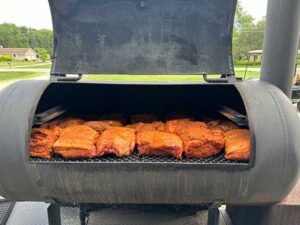
American barbecue is known for its regional diversity, and there are several distinct styles, each with its own cooking techniques, meats, sauces, and flavors. The major regional barbecue styles in the United States include:
Kansas City Style: Known for a wide variety of meats, including pork, beef, and chicken, often smoked and served with a thick, sweet tomato-based sauce.
Memphis Style: Famous for its pulled pork, particularly shoulder, and ribs. Memphis barbecue is often served dry (with a dry rub) or wet (with sauce), and it emphasizes the flavor of the meat itself.
Texas Style: This style is divided into several sub-regions, including:
- Central Texas: Focuses on brisket, sausage, and ribs, often served with minimal sauce, allowing the smoke flavor to shine.
- East Texas: Typically uses a sweeter sauce and often has a focus on chopped beef or pork.
- West Texas: Known for its use of mesquite wood and often features more beef-centric dishes.
North Carolina Style: Divided into two main styles:
- Eastern North Carolina: Uses the whole hog, with a tangy vinegar-based sauce.
- Western North Carolina (Lexington Style): Focuses on pork shoulder and uses a tomato-based sauce with vinegar.
South Carolina Style: Known for its mustard-based sauce, often served with pulled pork. There are also variations like the vinegar-pepper sauce.
Alabama Style: Famous for its white sauce, a mayonnaise-based sauce typically served with chicken.
Tennessee Style: Like Memphis but often incorporates a wider variety of meats and can include both dry and wet preparations.
Each of these styles has its unique characteristics, and there can be further variations within regions and even individual restaurants. Overall, while these are the major recognized styles, the creativity and local influences mean that the number of barbecue styles can be quite extensive. America’s regional barbecue styles have developed due to a combination of historical, cultural, geographical, and agricultural factors.
Cultural Influences: The United States is a melting pot of cultures, each bringing its own cooking traditions and flavors. For example, African, Native American, European, and Caribbean influences have all contributed to the development of barbecue techniques and flavor profiles in different regions.
Geographical Variations: Different regions have access to various types of wood for smoking, which affects the flavor of the barbecue. For instance, mesquite is prevalent in Texas, while hickory is more common in the Midwest. The availability of local meats, such as pork in the Carolinas or beef in Texas, also influences regional styles.
Local Ingredients: The types of meat and sauces used in barbecue often reflect what is locally available. For example, North Carolina is known for its pork, whereas Kansas City features a wide variety of meats, including beef and chicken since it was a historical area for stockyards.
Historical Context: The history of each region plays a significant role. In the South, barbecue became a communal and celebratory food, often associated with gatherings and social events. The cooking methods and recipes were passed down through generations, leading to regional variations.
Economic Factors: The economics of agriculture have influenced barbecue styles. In areas with a surplus of hog farming, such as the Carolinas, pork became a staple. In contrast, Texas’s cattle ranching history has led to a focus on beef.
Adaptation and Innovation: As people moved across the country, they brought their barbecue traditions with them, leading to adaptations based on local tastes and ingredients. This has resulted in the fusion of styles and the creation of new barbecue techniques.
Competition and Pride: Barbecue competitions, festivals, and restaurants have fostered a sense of pride in regional styles, encouraging chefs and pit-masters to hone their craft and innovate while staying true to their regional roots.
Social and Community Bonds: Barbecue often serves to bring people together, whether at backyard cookouts, festivals, or competitions, leading to the preservation and promotion of regional styles.
These factors, combined with the deep-rooted cultural significance of barbecue in American life, have resulted in a rich tapestry of regional styles, each with its own unique identity and flavor.